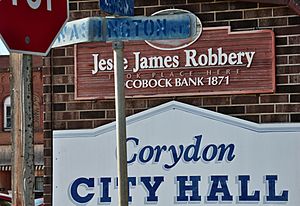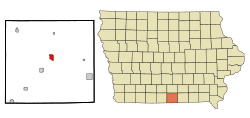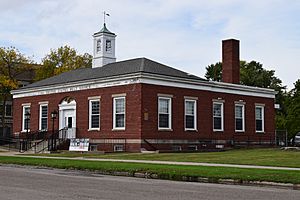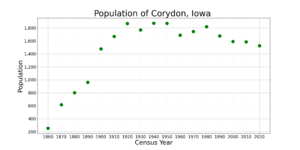Corydon, Iowa facts for kids
Quick facts for kids
Corydon, Iowa
|
|
|---|---|
 |
|

Location of Corydon, Iowa
|
|
| Country | |
| State | |
| County | Wayne |
| Incorporated | April 27, 1867 |
| Government | |
| • Type | (As of 2018) |
| Area | |
| • Total | 1.35 sq mi (3.49 km2) |
| • Land | 1.35 sq mi (3.49 km2) |
| • Water | 0.00 sq mi (0.00 km2) |
| Elevation | 1,093 ft (333 m) |
| Population
(2020)
|
|
| • Total | 1,526 |
| • Density | 1,131.21/sq mi (436.69/km2) |
| Time zone | UTC-6 (Central (CST)) |
| • Summer (DST) | UTC-5 (CDT) |
| ZIP code |
50060
|
| Area code(s) | 641 |
| FIPS code | 19-16635 |
| GNIS feature ID | 2393642 |
Corydon is a small city in Wayne County, Iowa, in the United States. It is the county seat of Wayne County, which means it's where the main government offices for the county are. In 2020, about 1,526 people lived there. The town was started in 1851. It was named by Judge Seth Anderson, who missed his old home in Corydon, Indiana.
Contents
About Corydon, Iowa
Corydon is a small city, covering about 1.35 square miles (3.49 square kilometers) of land. It is located in the state of Iowa.
Population Changes Over Time
The number of people living in Corydon has changed over the years. Here's a quick look at its population from different census counts:
- 1860: 254 people
- 1870: 618 people
- 1880: 801 people
- 1890: 962 people
- 1900: 1,477 people
- 1910: 1,669 people
- 1920: 1,867 people
- 1930: 1,768 people
- 1940: 1,872 people
- 1950: 1,870 people
- 1960: 1,687 people
- 1970: 1,745 people
- 1980: 1,818 people
- 1990: 1,675 people
- 2000: 1,591 people
- 2010: 1,585 people
- 2020: 1,526 people
Who Lives in Corydon?
In 2020, there were 1,526 people living in Corydon. Most people living there were White (96.5%). A small number of people were Black, Native American, Asian, or Pacific Islander. About 0.9% of the population was Hispanic or Latino.
The average age in Corydon was about 43.1 years old. About 23.1% of the people were under 20 years old. Also, 25.3% of the people were 65 years or older. There were slightly more females (54.7%) than males (45.3%) in the city.
Fun Things to See and Do
Corydon has some interesting places to visit, especially if you like history!
Prairie Trails Museum
The Prairie Trails Museum of Wayne County is a great place to explore. It has a large brick building with 25,000 old items in five big rooms. There's also a barn filled with old farm tools. You can learn about the Mormon Trail and see a display of the old Ocobock Bank. This bank was once robbed by a famous outlaw named Jesse James in 1871.
Post Office Mural
The Corydon post office has a special painting inside called Volunteer Fire Department. It was painted in 1942 by an artist named Marion Gilmore. Many murals like this were created in post offices across the United States during the 1930s and 1940s.
Schools and Getting Around
Corydon has its own public school system and ways to travel.
Education in Corydon
The Wayne Community School District is in charge of the public schools in Corydon. Students in the area attend these schools.
Transportation
Corydon is easy to reach by car, as it's served by Iowa Highways 2 and 14. These highways go around the southern and eastern parts of the town square.
Trains also pass through Corydon. The Union Pacific Railroad uses a line that was once part of the "Rock Island" railroad. This line is now an important route for trains traveling between Kansas City and Minneapolis. In the past, Corydon was also served by the CB&Q Railroad, but that line is no longer in use.
Famous People from Corydon
Some notable people have come from Corydon, Iowa:
- Karl M. LeCompte – A U.S. Representative who served in the government.
- Katherine Marlowe – A film actress, known for her role in the movie Dodsworth.
- George Saling – An Olympic athlete who won a gold medal in the 1932 Summer Olympics.
See also
 In Spanish: Corydon (Iowa) para niños
In Spanish: Corydon (Iowa) para niños



